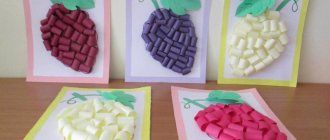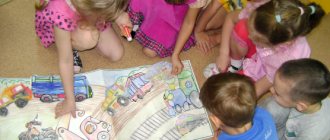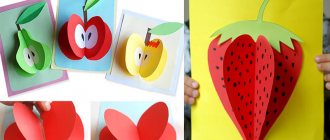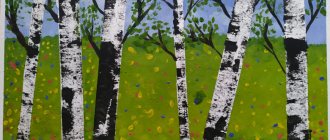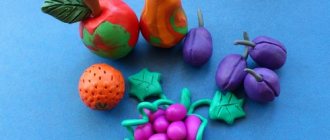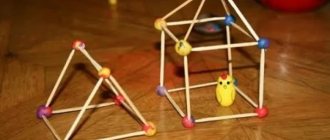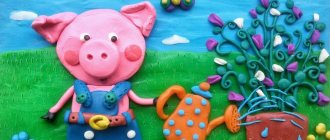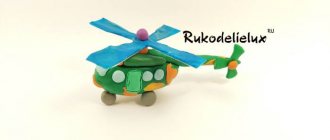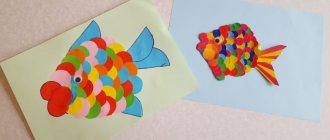Lesson in the preparatory group on sculpting “Fire Truck” (plasticineography)
Marina Smirnova (Solovieva)
Lesson in the preparatory group on sculpting “Fire Truck” (plasticineography)
Lesson in the preparatory group on sculpting “ Fire Engine ” ( plasticineography )
MBDOU "D/s No. 2 combined type"
preparatory group No. 2
Solovyova Marina Alekseevna
Educational: Teach children to draw “ Fire Truck ”
, achieve an accurate representation of the form, its structure and parts.
Developmental: Continue to develop an interest in working with plasticine using the familiar technique - plasticineography , develop fine motor skills.
Educational: to cultivate accuracy when doing work, to activate children’s imagination, to instill in children respect for a profession such as a firefighter , a respectful attitude towards their hard work, and an awareness of the dangers of this profession.
Preliminary work: Looking at illustrations with different types of transport, guessing riddles, reading poems on the topic, finger gymnastics “ cars ”
Materials and equipment:
Demonstration: photo of a fire truck .
Handout: Cardboard for each child, plasticine modeling board .
Looking at an illustration on the topic “ Fire Safety ”
; reading fiction.
Progress of the lesson:
Playback :Guys, guess the riddle:
The red tongue is not used to dozing.
Once or twice he licked all the wood. (fire)
Playback : What words helped you solve the riddle? (Red, licked all the wood)
Playback : You and I know how fire arises and who fights it. Just like in a real battle, firefighters suffer heavy losses in the fight against fire and constantly live a tense life full of anxiety from the dangers. This is a highly qualified service with an alarm system, powerful fire engines , pumping units, and special heat-protective suits. These people need to bow deeply for their work. It is necessary to respect their profession and be grateful for the work of these people, for their willingness to risk their lives to save others from harm. Tell me, how do firefighters get to a fire ? ( Firemen ride in cars )
Playback : Great, but our firefighters’ cars have broken down and they can’t save people. What should they do now? (We need to make fire trucks )
Playback : Let's help them and make fire trucks . And cars using a technique already known to you and me - plasticineography . But first we will stretch our fingers so that we can get precise lines.
One two three four five. (They move the machine forward and backward over each finger, starting with the thumb.)
The race can begin. (Now the same thing, but starting with the ring finger.)
In a circle, in a circle, forward and backward, (Now - in a circle in one direction and the other.)
But my fingers are slowing down my car . (Roll the machine again over the fingers , which are slightly bent.)
Closed. (They clench their fist.)
The car is already in the garage.
And the headlights went out, they don’t shine anymore. (They look into the small crack in the fist.)
Playback : Well done! We will carry out our work in three stages. And for this we need a sheet of cardboard, a simple pencil and colored plasticine .
Stage 1. Using a simple pencil, we draw the silhouette of a fire truck .
Stage 2. Apply red plasticine
Stage 3. Done! Now we need to add elements so that our machine
She looked like a firefighter . Add a ladder, a sleeve and number 01.
The children do the work.
An exhibition of fire engines . Children look at them, listen to the opinions of their comrades without interrupting them, and share their impressions.
Summary of direct educational activities in artistic creativity (drawing) on the topic “Fire Engine” Summary of direct educational activities in artistic creativity (drawing) on the topic “Fire Engine” Purpose: To consolidate.
Abstract of OOD on design in the preparatory group “Time Machine”. Program content: consolidate children's knowledge about time, professions, transport, continue to develop the skill of independently composing. Sculpting lesson notes. Plasticineography “Summer Forest” Tatyana Tuktamysheva Lesson summary on lenka (plasticineography) “Summer Forest” Goals and objectives: * development of fine motor skills * development of imagination. Master class “Do-it-yourself fire truck” All children really like to play with cars, and even girls! Children are especially attracted to construction equipment and special equipment. transport. And also kids. GCD for drawing in the preparatory group “A fire truck is rushing to a fire” “A fire truck is rushing to a fire” Program content: learn to convey proportions between objects and partial occlusion in a plot drawing. "Sunflower". Summary of a lesson on modeling using the non-traditional technique “plasticineography” in the middle group b] Goals and objectives. Teach children to create an image of a sunflower based on an unfinished composition (silhouette of a sunflower). Keep learning. Modeling lesson in the senior group “Here it is, the fragrant bread” (plasticineography) The children chose the theme for modeling on their own. Among all baked goods, bread turned out to be the most important, the most delicious, the most necessary.
Summary of the lesson on sculpting “Cars”
Ekaterina Duke
Summary of the lesson on sculpting “Cars”
Artistic and aesthetic development. Modeling "Cars"
Goal: creating a social development situation in the process of artistic and aesthetic activity
Tasks:
• Formation of skills in sculpting a car from rolled out balls
• Continue to teach children to sculpt an object consisting of several parts of the same shape, but of different sizes.
• Develop speech and attention.
• Cultivate a sense of compassion for others.
Materials: plasticine, soft toy Murzik the cat, napkins, napkins for modeling.
Progress of the lesson
There's a knock on the door. Guys, someone came to visit us, I’ll go and have a look. The cat Murzik comes in.
Say hello to the guys! What a beautiful cat, fluffy and soft.
Murzik, you are so scared, who scared you so much? Guys, when I was walking towards you, I saw something like that on the street, they were honking, driving fast, fast, beeping (honking, I was so scared, what was it?
Educator: Children, what do you think scared our cat so much?
Murzik, sit and listen, the children will tell you everything they know about cars.
There are toy cars on the table.
Educator: Children, what do you see on the table? These are cars, how many are there?
Educator: This is a passenger car, it has wheels, windows, a steering wheel.
What kind of car is this?
Educator: Do you know what this car is called?
This is a truck, it has a body, windows, and a steering wheel. The truck can carry,
various loads in its body. Ask one of the children to take the cubes and unload them.
Can we transport the cubes in a small car?
Murzik, now you know what cars are, what kinds of cars there are.
Guys, when Murzik goes home, how can he cross the road? Are there cars driving there?
While the music is playing, you drive like a car, only the music stops playing and you stop.
Murzik, now guys, they’ll show you how you can make small cars out of plasticine at home
Summary of a modeling lesson on the topic: “Bus”
Eresek tobyndagy uyimdastyrylgan oku kyzmetіnіn abstracts
Summary of organized educational activities in the senior group
Event description/Date:
01/30/2018
Bilim take salas/Educational area:
Creation
Pәn/Item:
Modeling
Overall/Cross-cutting theme:
" Transport"
Takyryby/Topic:
"Bus"
Maksattaras/Goals:
Tarbielik – educational:
Foster a caring attitude towards birds, a love for wildlife and a desire to care for birds; accuracy and attentiveness.
Damytushylyk – developing:
develop in children creative abilities, a sense of beauty, the ability to understand and appreciate the beauty and richness of the world around them.
Oqytu – educational:
continue to teach children to carefully glue parts, use glue and a brush; fix the names of geometric shapes;
Pedagogical technology/Pedagogical technologies:
health-saving, gaming
Resurstarmen kamatamasyz etu/Resource support:
Koptildilyk/Multilingualism:
kus – bird – bird
Uyimdastyrylgan oku kyzmetinin Barysy
Progress of organized educational activities
Ұyimdastyrushylyk kezeni/Organizational point:
As you know, in winter there is a lot of snow, it lies on the ground, trees, roofs of houses and it is very difficult for birds to find food under the snow. Winter is terrible for birds not because of cold, but because of hunger. Feeders need to be filled every day. After all, if a bird is full, then it is warm under its down and feathers.
The teacher draws attention to the fact that today the Wise Owl came to visit us, he will tell us riddles about his friends, and you will try to guess them.
Red-breasted, black-winged, loves to peck grains. With the first snow on the mountain ash, He will appear again. Apples on the branches in winter! Collect them quickly! And suddenly the apples flew up, After all, this is... (Bullfinches)
With a yellow breast at the window Quickly collects crumbs Guess what kind of bird it is? It's called... (Tit)
Negіzi bolіmі/Main part:
Conducts a conversation:
-Well done! Meet the bullfinch. Show illustrations. The bullfinch got its name because it flies to us along with the snow and lives all winter. The bullfinch is a beautiful, calm bird. Look carefully and remember what it looks like. The top of its head, wings and tail are black. And the chest, belly and cheeks are red. The bullfinch's beak is short and thick.
The tit is a small bird. A characteristic feature of the tit is its bright plumage. The head, throat and chest of this bird are black, the wings are gray-blue, the back is olive in color, and the belly is yellow. Males and females can be distinguished by a stripe on the abdomen: in males it widens, and in females it narrows, this is clearly visible in the photo. In winter, tits do not leave their habitat, but only move closer to human habitation.
Physical exercise "Bullfinches"
Look at the branches, (They clap their sides with their hands) There are bullfinches in red T-shirts. (Showing their breasts) Feathers spread out, (Arms slightly to the sides,) Basking in the sun. (Wiggle their fingers) Turn their heads, turn them, (Turn their heads to the right, left ) They want to fly away. (They run in a circle, waving their arms) Shoo! Shoo! Let's fly away!
Explanation and demonstration of the work sequence:
I suggest the children prepare parts for the birds (torso and chest). Smoothly cut off the corners of rectangles and squares so that the shape is an oval and a circle, respectively.
I offer children:
Place the appliqué parts on the sheet using the sample as a support.
Glue each part sequentially.
Korytyndy/Final part:
-What are these birds called? (Bullfinch, tit) - Name what the bird has? (Torso, wings, head) - What color are the bullfinch’s feathers? (Red and black)
— What color is a tit’s breast? (Yellow) Well done guys, the wise owl thanks you and says thank you. Guys, look at the bullfinches and tits we got, how beautifully they sit on the branches, how neatly they are glued on.
Technological map for sculpting “Machines” in the senior group
Irina Getman
Technological map for sculpting “Machines” in the senior group
Educational field: Creativity.
Section: Modeling .
Topic: Cars .
Goal: the ability to convey the characteristic features of a car using plasticineography techniques .
— deepen and expand children’s knowledge about ground transport;
- learn to identify similar and different characteristics of cars and trucks - size , color, shape;
- learn to identify parts of cars - trunk , hood, body, wheels, steering wheel, etc.;
— develop the ability to paint over an image of a car with plasticine;
— continue to introduce children to the unconventional drawing technique “plasticineography”
— conversation about cars and trucks;
- examination of subject pictures “Cars”
;
— reading poems and riddles about cars;
— p/i “Sparrows and Cars”
— cars;
— illustrations depicting cars;
“ machine ” handout
- blank images of cars (for each child)
There's a knock on the door. Guys, someone came to visit us, I’ll go and have a look. Bunny comes in.
Say hello to the guys! What a beautiful bunny, fluffy and soft.
Bunny, what happened to you, who scared you so much?
Guys, when I was walking towards you, I saw something like that on the street, they were honking, running fast, fast, beeping (honking, I was so scared, what was it?
Educator: Children, what do you think scared our bunny so much?
Children: cars
Bunny, sit and listen, the children will tell you everything they know about cars .
There are toy cars .
Educator: Children, what do you see on the table? These are cars , how many are there?
Educator: This is a passenger car, it has wheels, windows, a steering wheel.
car is this ?
Educator: Do you know what this car is called ?
This is a truck , it has a body, windows, and a steering wheel. The truck can transport ,
various loads in your body (sand, bricks, furniture)
.
Can we transport cargo in a small car
Bunny, now you know what cars , what types of cars there are .
Guys, when the Bunny goes home, how can he cross the road? Are there cars driving ?
Let's play with our hands
And remember about transport (connect fingers with thumb)
Let's fly on an airplane
Clouds, how are you living? (Represents the wings of an airplane)
Rocking in a boat
And we smile at the waves (Palms in a boat shape)
, depict waves)
We accelerate the motorcycle,
We play races (Clench your fingers into a fist, relax)
With wind, sun and friends. (Hands in a tube - blowing like a breeze)
; hands up are the rays of the sun. Hands point to friends)
Call transport with us. (Press the pads of the fingers against each other on the corresponding hands)
Bunny, now the guys will show you how you can make small cars from plasticine .
But we will not only sculpt, but also decorate our cars . You say, but we don’t have paints.
How will we paint with plasticine?
Let's sit down at the tables and paint the cars in bright colors .
(The teacher hands out car )
Familiarity with the depicted subject. Selecting a machine .
Showing the sequence of actions and sculpting .
1. Apply blue plasticine to the drawing, carefully, without going beyond the outline.
2.Now we need to add elements: wheels – black, headlights – yellow. Children choose any colors themselves.
You guys are so great! It turned out very well! Our cars are painted .
Reproduce: how to sculpt a car;
They understand: what parts the car consists of;
Apply: the ability to paint over an image of a car with plasticine, using the unconventional technique “plasticineography”
.
Technological map “Letters from the Queen of Mathematics” Technological map of organized educational activities in the senior group Educational area: “Cognition”. Section: "FEMP". Letter subject.
Modeling a car from plasticine
What little boy can live and play without a small car? This doesn't happen. Parents buy almost dozens of all kinds of toy models for their tomboys. But not all adults and children create toys on their own from plasticine, fearing that nothing will come of this idea. We offer you a detailed guide to sculpting a car from plasticine, which will completely dispel your doubts and help you achieve your plans.
To sculpt a small passenger car we used:
- one block of brown plasticine;
- some black, white, gray and blue material;
- stack and body from an old ballpoint pen.
1. In this work, you should use an untouched block of plasticine - this will speed up and facilitate the process as much as possible. If you take an already used crushed block, then you will need to independently form a rectangular workpiece and cut the sides, and in this case the stack must be very sharp.
2. So, if you have a whole (untouched) block of plasticine available, then it will do just fine. In this tutorial we showed an example of a brown car, but it can be any other color. Mentally divide the block lengthwise into approximately three parts. Cut one part into a stack.
3. Turn the block towards you with the flat side. Flatten the smaller part.
4. Stick the blanks on top of each other to form a machine body.
5. Using the body of a ballpoint pen, press the recesses for the wheels in the right places, symmetrically.
6. To make the wheels, start by rolling four black balls.
7. Press each ball down with your finger. Insert into the hole. Apply an axial pattern in a stack.
8. Decorate the back. There should be blue (white) glass, dimensions, and a rear bumper with a number.
9. It’s also easy to make a car’s face – you need to add a windshield, headlights and front bumper.
10. Continuing the design, decorate the side parts of the cabin. You need to attach the glass and cut out the doors in stacks.
11. And be sure to attach the rear view mirrors - they will be small gray cakes.
So your little stylish plasticine car is ready. Isn't this a wonderful gift for a boy?
If you find an error, please select a piece of text and press Ctrl+Enter.
Olesya Selikhova
About the author: Psychologist, specialist in the field of family relationships and raising children. I love drawing, modeling, needlework and any interesting creativity. Mom raising two children and a wonderful wife!
technique
Share with friends:
We also recommend watching!
How to make a horse from plasticine
Modeling a dragon from plasticine
How to make a soldier from plasticine
Ladybug made of plasticine
How to make a helicopter from plasticine.
How to make a caterpillar from plasticine.
Chicken made of plasticine
How to make a minion from plasticine.
How to make an owl from plasticine
How to make a tank from plasticine
How to make a bear from plasticine.
How to mold a man from plasticine.
